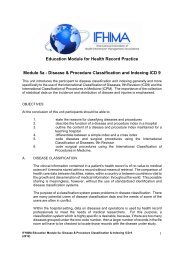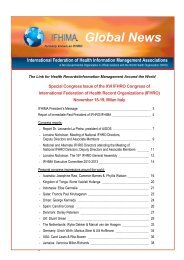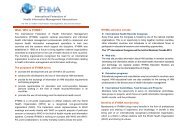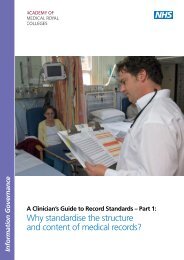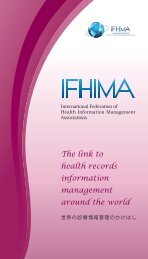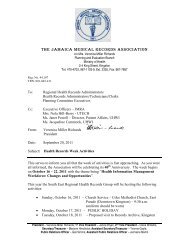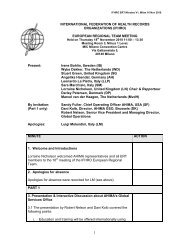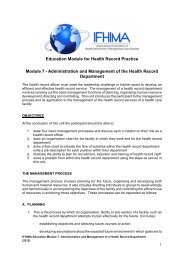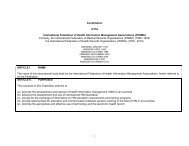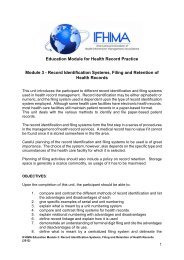Education Module for Health Record Practice Module 5d ... - ifhima
Education Module for Health Record Practice Module 5d ... - ifhima
Education Module for Health Record Practice Module 5d ... - ifhima
You also want an ePaper? Increase the reach of your titles
YUMPU automatically turns print PDFs into web optimized ePapers that Google loves.
<strong>Education</strong> <strong>Module</strong> <strong>for</strong> <strong>Health</strong> <strong>Record</strong> <strong>Practice</strong><br />
<strong>Module</strong> <strong>5d</strong> - Coding Diseases of the Respiratory System, Digestive<br />
System and Genitourinary System<br />
Study Notes and Coding Exercise 7 (ICD 9)<br />
a) Chapter VIII - Diseases of the Respiratory System<br />
At the beginning of this chapter there is a note which states that an additional<br />
code may be used to identify the infectious organism which causes the<br />
respiratory disease. The code <strong>for</strong> the infectious organism will come from chapter<br />
1 and can be found in the Alphabetical Index under the lead term "infection".<br />
The exclusion note <strong>for</strong> code 496 must be followed. This means that a patient<br />
with chronic obstructive airways disease due to asthma will be coded to the<br />
asthma not the chronic obstructive airways disease. The terminology used to<br />
describe chronic airways obstruction differs from country to country. In the<br />
Alphabetic Index code 496 appears under the term chronic obstructive lung<br />
disease.<br />
Under code 506, Respiratory conditions due to chemical fumes and vapours,<br />
there is a note indicating that an E code can be used to identify the chemical<br />
fumes specifically. These E codes are located by using the Table of Drugs and<br />
Chemicals, Section III, of the Alphabetical Index.<br />
b) Chapter IX - Diseases of the Digestive System<br />
The chapter <strong>for</strong> the diseases of the digestive system is organised on an<br />
anatomical basis working through the digestive system from the mouth down.<br />
The codes 531-534 have a standard set of fourth digit subdivisions.<br />
c) Chapter X - Diseases of the Genitourinary System<br />
The first block of codes in this chapter, 580-584 have a standard set of fourth<br />
digits. However, because these fourth digits do not apply to every code, there<br />
are gaps in the sequence of numbers. You will notice, there is a code 580.0 and<br />
580.4 but no 580.1, 580.2 or 580.3.<br />
Code the following exercise. Do not <strong>for</strong>get to check your answers AFTER<br />
completing the whole exercise.<br />
IFHIMA <strong>Education</strong> <strong>Module</strong> <strong>5d</strong>: Coding Exercise 7 ICD 9 Respiratory System, Digestive System &<br />
Genito Urinary System Study Notes & Exercises (2012)<br />
1
EXERCISE 7<br />
1. Chronic obstructive lung disease ______________<br />
2. Compensatory emphysema ______________<br />
3. Shock lung ______________<br />
4. Croup ______________<br />
5. Influenza ______________<br />
6. Asthmatic bronchitis ______________<br />
7. Chronic respiratory disease ______________<br />
8. Pleural effusion ______________<br />
9. Fibrosis of lung following radiation ______________<br />
10. Aspiration pneumonia ______________<br />
11. Farmer's lung ______________<br />
12. Mesenteric thrombosis ______________<br />
13. Incarcerated inguinal hernia ______________<br />
14. Gastric ulcer with hemorrhage ______________<br />
15. Gastric hemorrhage ______________<br />
16. Calculus of bile duct, acute cholecystitis ______________<br />
17. Liver damage from alcohol ______________<br />
18. Malfunction of colostomy ______________<br />
19. Celiac disease ______________<br />
20. Cholangitis ______________<br />
21. Ulcer of esophagus due to ingestion of aspirin ______________<br />
22. Tubular necrosis ______________<br />
23. Nephrogenic diabetes insipidus ______________<br />
24. Hemorrhagic nephroso-nephritis ______________<br />
25. Cyst of Bartholin's gland ______________<br />
26. Acute proliferative glomerulonephritis ______________<br />
IFHIMA <strong>Education</strong> <strong>Module</strong> <strong>5d</strong>: Coding Exercise 7 ICD 9 Respiratory System, Digestive System &<br />
Genito Urinary System Study Notes & Exercises (2012)<br />
2
27. Uremia ______________<br />
28. Cervicitis ______________<br />
29. Nephropathy ______________<br />
30. Lipoid nephrosis ______________<br />
31. Acute renal failure ______________<br />
32. Cystic breast ______________<br />
IFHIMA <strong>Education</strong> <strong>Module</strong> <strong>5d</strong>: Coding Exercise 7 ICD 9 Respiratory System, Digestive System &<br />
Genito Urinary System Study Notes & Exercises (2012)<br />
3
8. CODING OBSTETRIC AND NEONATAL CONDITIONS<br />
a) Chapter XI - Complications of Pregnancy, Childbirth and the Puerperium<br />
This chapter on complications of pregnancy, childbirth and the puerperium is<br />
divided into the following blocks:-<br />
. Codes 630-639 Pregnancy with abortive outcome.<br />
This is a self-contained block of conditions where no delivery will follow. Note the<br />
list of four digit sub-categories common to Codes 634-638. These complications<br />
are re-listed at Code 639 so that:<br />
- where a patient is readmitted with a complication, Code 639. is used.<br />
- where these complications occur with codes 630-633, 639.- is used.<br />
- Codes 640-648 Complications mainly related to pregnancy.<br />
- Codes 650-659 Normal delivery and other indications <strong>for</strong> care in<br />
pregnancy, labour and delivery.<br />
. Codes 660-669 Complications occurring mainly in the course of labour<br />
and delivery.<br />
. Codes 670-676 Complications of the puerperium.<br />
In the three blocks <strong>for</strong> complications of the three phases (pregnancy,<br />
labour/delivery, and puerperium) the complication is listed once only, placed in<br />
the phase where it is most likely to cause problems. This means that the<br />
condition is classifiable to that code even if the patient whose record is being<br />
coded has developed the complication in a different phase. There is no<br />
restriction placed on the coder to match the record being coded to the time<br />
phases indicated in these blocks.<br />
It may be statistically desirable <strong>for</strong> a hospital to be able to identify that the delivery<br />
has taken place. Study the explanation of Code 650. This code cannot be<br />
allocated if any other code from the chapter applies. Consider two women with<br />
pre-eclamptic toxemia, one in hospital <strong>for</strong> medical care not having given birth,<br />
and one who has had a completely normal labour and spontaneous<br />
delivery. Both are coded 642.2 and the outcome code distinguishes the record of<br />
the woman who has given birth.<br />
The optional fifth digits <strong>for</strong> method of delivery could also per<strong>for</strong>m this function of<br />
indicating the delivery episode of care.<br />
b) Alphabetical Index to Obstetric Coding<br />
There are a variety of methods with which obstetric codes are indexed. The lists<br />
which are most comprehensive and useful are:<br />
- Delivery - in particular there are very useful lists under delivery<br />
complicated by<br />
IFHIMA <strong>Education</strong> <strong>Module</strong> <strong>5d</strong>: Coding Exercise 7 ICD 9 Respiratory System, Digestive System &<br />
Genito Urinary System Study Notes & Exercises (2012)<br />
4
- Pregnancy - especially pregnancy, complicated by and pregnancy,<br />
management affected by<br />
In addition, conditions may be indexed in their own right; <strong>for</strong> example, fetopelvic<br />
disproportion. There is also an entry <strong>for</strong> fetopelvic disproportion in the "delivery,<br />
complicated by" list; however, the code given here is different because the<br />
obstructed labour is presumed. Careful consultation with both volumes is<br />
recommended.<br />
c) Special Notes<br />
(i)<br />
Codes 652, 653 and 654 are provided to code the presence of these<br />
abnormal conditions when they are present but do not complicate the<br />
labour. See exclusion note to codes 660.0, 660.1 and 660.2 at the three<br />
digit level of 652, 653 and 654. However, these codes may be used in<br />
addition to codes from 660.- because they are more specific regarding<br />
the nature of the cause of the obstructed labour. Notes at 660.0, 660.1<br />
and 660.2 direct the coder to "use additional code ... if desired, to identify<br />
condition".<br />
For example - Obstructed labour due to inlet contraction of pelvis code<br />
660.1 and 653.2<br />
(ii) Codes 647.- and 648.-<br />
These categories are <strong>for</strong> conditions normally coded elsewhere in ICD9. If<br />
the disease complicates the pregnancy or the pregnancy aggravates the<br />
disease or the disease is stated as a main reason <strong>for</strong> care being<br />
provided, then 647.- or 648.- are used. These codes do not apply when<br />
the disease is being recorded as incidental during a pregnancy.<br />
To locate these codes in the alphabetical index see the "Pregnancy<br />
complicated by" list. It may be necessary to locate the usual ICD9 code<br />
to use the "Pregnancy complicated by conditions in" list which is<br />
organised by code numbers.<br />
d) V Codes Used in Obstetrics<br />
Two V codes may be used in connection with obstetric and newborn records.<br />
V27.- may be used on the mothers record to code the outcome of delivery. (See<br />
Volume 1 and Volume 2 under “Outcomes”).<br />
V30.- may be used on the healthy baby's record. (See Volume 1 and Volume 2<br />
under “Infants, healthy liveborn”).<br />
The decision to use these codes rests with each hospital.<br />
e) Coding Neonatal Conditions - Chapter XIV - Congenital Anomalies<br />
This chapter is used to code gross structural congenital mal<strong>for</strong>mations. The<br />
codes from this chapter may be used on the records of adults who have<br />
congenital disorders as well as on newborn babies' records.<br />
IFHIMA <strong>Education</strong> <strong>Module</strong> <strong>5d</strong>: Coding Exercise 7 ICD 9 Respiratory System, Digestive System &<br />
Genito Urinary System Study Notes & Exercises (2012)<br />
5
f) Chapter XV - Certain Conditions Originating in the Perinatal Period<br />
This chapter is used to code conditions which arise as a consequence of the fetal<br />
environment, birth process or the infant's taking time to adjust to the extrauterine<br />
environment. Often these are transitory conditions, <strong>for</strong> example, 775.0 Syndrome<br />
of infant of diabetic mother or, 777.4 Transitory ileus of newborn. To be coded in<br />
chapter XV the condition must be qualified as neonatal, of newborn, transient or<br />
sometimes congenital.<br />
There is an inclusion note <strong>for</strong> the whole chapter reminding coders that these<br />
codes may be used even if the illness or death occurs later than the perinatal<br />
period. The index should be followed carefully.<br />
Take your time to code the following exercise.<br />
IFHIMA <strong>Education</strong> <strong>Module</strong> <strong>5d</strong>: Coding Exercise 7 ICD 9 Respiratory System, Digestive System &<br />
Genito Urinary System Study Notes & Exercises (2012)<br />
6
EXERCISE 8<br />
1. Patient was admitted with an antepartum<br />
hemorrhage which settled with bed rest,<br />
discharged undelivered.<br />
_______________<br />
2. Patient was admitted in severe pain following _______________<br />
a ruptured tubal pregnancy. Removal of<br />
ruptured tubal pregnancy was per<strong>for</strong>med.<br />
_______________<br />
3. This patient was admitted because of<br />
deterioration during pregnancy of her<br />
longstanding mitral insufficiency. She was<br />
discharged following medical assessment of her condition.<br />
4. This patient was admitted <strong>for</strong> a termination<br />
of pregnancy because of a CNS mal<strong>for</strong>mation of<br />
the fetus diagnosed by amniocentesis at the<br />
_______________<br />
outpatient department. The termination was<br />
achieved by injection of Prostaglandin.<br />
_______________<br />
_______________<br />
5. This patient was admitted with symptoms of<br />
a threatened abortion. Symptoms settled with<br />
bed rest and the patient was discharged undelivered.<br />
_______________<br />
6. Patient had a term delivery complicated by a _______________<br />
retained placenta without haemorrhage.<br />
A manual removal of placenta was per<strong>for</strong>med.<br />
_______________<br />
7. Patient admitted in early pregnancy with hyperemesis<br />
gravidarum leading to dehydration.<br />
_______________<br />
8. This patient with cervical incompetence was _______________<br />
admitted <strong>for</strong> removal of Shirodkar suture.<br />
Discharged to await onset of labour.<br />
_______________<br />
9. This patient was re-admitted following a previous<br />
admission <strong>for</strong> legal termination of pregnancy<br />
because of a haemorrhage.<br />
_______________<br />
10. Patient had an obstructed labour due to an inlet _______________<br />
contraction of the pelvis. A lower segment<br />
cesarean section was per<strong>for</strong>med.<br />
_______________<br />
_______________<br />
11. During this labour the baby showed signs of _______________<br />
fetal bradycardia so a mid <strong>for</strong>ceps delivery<br />
with episiotomy was per<strong>for</strong>med.<br />
_______________<br />
IFHIMA <strong>Education</strong> <strong>Module</strong> <strong>5d</strong>: Coding Exercise 7 ICD 9 Respiratory System, Digestive System &<br />
Genito Urinary System Study Notes & Exercises (2012)<br />
7
12. Full term normal delivery _______________<br />
_______________<br />
13. Spontaneous abortion with dilatation and _______________<br />
curettage was per<strong>for</strong>med<br />
_______________<br />
14. This patient was admitted <strong>for</strong> a termination _______________<br />
of pregnancy which was per<strong>for</strong>med by<br />
aspiration currettage.<br />
_______________<br />
15. The patient was admitted post-dates _______________<br />
<strong>for</strong> induction of labour by artificial<br />
rupture of membranes. When this procedure<br />
_______________<br />
failed to induce the labour an IV<br />
syntocin drip was used. The baby was<br />
_______________<br />
delivered with the assistance of low <strong>for</strong>ceps.<br />
_______________<br />
_______________<br />
_______________<br />
16. This patient was admitted <strong>for</strong> a booked cesarean _______________<br />
section because of a scar from a previous cesarean<br />
section. Lower segment cesarean section was per<strong>for</strong>med. _______________<br />
17. Hypertensive disease of pregnancy with severe edema. _______________<br />
18. Incomplete abortion complicated by renal shut down. _______________<br />
Dilatation and curettage per<strong>for</strong>med.<br />
_______________<br />
IFHIMA <strong>Education</strong> <strong>Module</strong> <strong>5d</strong>: Coding Exercise 7 ICD 9 Respiratory System, Digestive System &<br />
Genito Urinary System Study Notes & Exercises (2012)<br />
8
9. CODING DISEASES OF THE SKIN, MUSCULOSKELETAL SYSTEM AND SYMPTOMS<br />
SIGNS AND ILL DEFINED CONDITIONS<br />
a) Chapter XII - Diseases of Skin and Subcutaneous Tissue<br />
There is an exclusion note that indicates certain local skin infections are not<br />
coded in this chapter, but are included in chapter 1, Infectious and parasitic<br />
disease.<br />
Code 682, Other cellulitis and abscess begins with the inclusion and exclusion<br />
notes. Coders sometimes make errors because they do not notice these<br />
exclusion notes when checking the codes.<br />
The difference between code 692.3 and 693.0 is in the type of exposure to the<br />
drug. Topical applications are coded 692.3, if ingested 693.0. Code 995.2<br />
should be used only when the adverse effect or the route of administration is not<br />
specified, [e.g. rash due to penicillin].<br />
b) Chapter XIII - Diseases of the Musculoskeletal System and Connective<br />
Tissue<br />
The fifth digits <strong>for</strong> this chapter are listed at the beginning of the section. The fifth<br />
digits provide the anatomical location of the disease. As noted above in chapter<br />
5 however, the use of these fifth digits provides useful in<strong>for</strong>mation <strong>for</strong> only a<br />
limited range of code numbers. The hospital should decide which codes are<br />
appropriate <strong>for</strong> the use of the fifth digit and ensure that these are used<br />
consistently by the coders.<br />
The terminology used <strong>for</strong> code 715 may need some further explanation:<br />
715.1 - one site, no cause<br />
715.2 - one site, secondary to some cause;<br />
e.g. old fracture<br />
715.8 - examples; hip and knee or both hips<br />
715.9 - this code is used when the number of sites<br />
are not specified nor the nature of the disease<br />
(generalized or localized)<br />
c) Chapter XVI - Symptoms, Signs and Ill Defined Conditions<br />
Chapter 16 supplies codes <strong>for</strong> symptoms, signs and ill-defined conditions which<br />
cannot be located in the chapter relating to a particular body system. There are<br />
notes that identify six occasions when codes from this chapter may be<br />
appropriate. Read these notes carefully noting these occasions. Codes from<br />
this chapter are not chosen if the symptom is a well recognised part of the<br />
disease process.<br />
[For example, if abdominal pain and acute appendicitis were both recorded on<br />
the front sheet of the health record, the acute appendicitis only would be coded.<br />
Of course this type of decision is dependent on the coding policy of each<br />
hospital].<br />
Now try the following - Exercise 9.<br />
IFHIMA <strong>Education</strong> <strong>Module</strong> <strong>5d</strong>: Coding Exercise 7 ICD 9 Respiratory System, Digestive System &<br />
Genito Urinary System Study Notes & Exercises (2012)<br />
9
EXERCISE 9<br />
1. Alopecia _______________<br />
2. Diaper rash _______________<br />
3. Abscess on chin _______________<br />
4. Pemphigus vulgaris _______________<br />
5. Poison ivy dermatitis _______________<br />
6. Impetigo _______________<br />
7. Rheumatoid arthritis _______________<br />
8. Systemic lupus erythematosus _______________<br />
9. Old bucket handle tear of meniscus of left knee _______________<br />
10. Ankylosing spondylitis _______________<br />
11. Sciatica - displacement of lumbar disc _______________<br />
12. Osteoarthritis right hip and knee _______________<br />
13. Gonococcal bursitis _______________<br />
14. Arthritis associated with ulcerative colitis _______________<br />
15. Juvenile osteochondrosis of calcaneum _______________<br />
16. Lumbago _______________<br />
17. Gangrene _______________<br />
18. Hepatomegaly _______________<br />
19. Ascites _______________<br />
20. Excessive blood level of alcohol _______________<br />
21. Excessive thirst _______________<br />
22. Senility _______________<br />
23. Benign heart murmur _______________<br />
24. Extravasation of urine _______________<br />
25. Cachexia _______________<br />
26. Sudden infant death syndrome _______________<br />
IFHIMA <strong>Education</strong> <strong>Module</strong> <strong>5d</strong>: Coding Exercise 7 ICD 9 Respiratory System, Digestive System &<br />
Genito Urinary System Study Notes & Exercises (2012)<br />
10
27. Viremia _______________<br />
IFHIMA <strong>Education</strong> <strong>Module</strong> <strong>5d</strong>: Coding Exercise 7 ICD 9 Respiratory System, Digestive System &<br />
Genito Urinary System Study Notes & Exercises (2012)<br />
11
10. TRAUMA CODING<br />
Many people are admitted to hospital following violent incidents which damage the body.<br />
The incident may be an accident or deliberately caused by another person (as in the<br />
case of assault) or even self inflicted.<br />
The codes <strong>for</strong> traumatic injuries are separated from the codes <strong>for</strong> diseases.<br />
There are two aspects of each trauma which require a code:<br />
. a code to cover the nature of the injury (from chapter XVII)<br />
. a code to cover the external cause of the injury (an E code)<br />
Codes from chapter XVII and E codes are companion codes and must always be used<br />
together.<br />
For example, fracture of shaft of the humerus following a fall from a horse is coded -<br />
812.2 and E828.2.<br />
a) Look-up Procedure<br />
To locate chapter XVII codes use Section I of Volume 2. First look up the specific<br />
name of the injury, [e.g. fracture, dislocation]. “Injury” is also a useful starting<br />
point. For lacerations, see “Wound, open”.<br />
To locate E codes use Section II of Volume 2. This section uses English not<br />
medical terminology. If you cannot find the entry you want rephrase it, [e.g.<br />
"struck by" see also "hit by", “motor vehicle accident” see “collision”].<br />
b) Chapter XVII - Injury and Poisoning<br />
Some patients are admitted with multiple injuries and it is usual to code each<br />
injury separately. However, some multiple injury codes are provided where<br />
insufficient detail of the component injuries is provided. Chapter XVII is divided<br />
into these sections:<br />
* 800-829 Fractures<br />
Notice that there is an exclusion note <strong>for</strong> the entire section regarding malunion<br />
and nonunion of fractures (code 733.8) and pathological or spontaneous<br />
fractures, that is nontraumatic fractures caused by disease (code 733.1).<br />
The fractures are arranged anatomically beginning with the head. Throughout<br />
the fracture section fourth digit decimals identify if the fracture is open or closed.<br />
In open fractures, there is an open skin wound. In closed fractures, there is no<br />
skin wound. Common fracture terms are grouped as being open or closed.<br />
However, if the patient had a compound and comminuted fracture, the open<br />
decimal would apply since open or closed is the issue being coded, not the type<br />
of fracture. Fracture NOS is assumed to be closed.<br />
In Volume II there is a fractures list. A detailed list of sites is provided including<br />
multiple sites if required.<br />
* 830-839 Dislocation<br />
IFHIMA <strong>Education</strong> <strong>Module</strong> <strong>5d</strong>: Coding Exercise 7 ICD 9 Respiratory System, Digestive System &<br />
Genito Urinary System Study Notes & Exercises (2012)<br />
12
This is an anatomically organised list with a fourth digit subdivision that usually<br />
signifies simple or compound dislocation.<br />
See exclusion notes <strong>for</strong> this section and arrangements of terms into simple<br />
and compound groups. An alphabetical index is found in this section.<br />
* 840-848 Sprains and Strains of Adjacent Muscles<br />
Note the inclusion and exclusion notes <strong>for</strong> this section. The most comprehensive<br />
alphabetical index entry is found under sprains.<br />
* 850-854 Intracranial Injury, excluding those with skull fracture.<br />
There are important exclusions in this section which should be noted.<br />
Coders should also note that the fourth digit decimals .0, without mention of<br />
intracranial wound, and .1 with open intracranial wound, do not apply to code 850<br />
concussion. The Alphabetical Index to this section appears under the lead term<br />
“Injury, intracranial”.<br />
* 860-869 Internal Injury of Chest, Abdomen and Pelvis<br />
See inclusion and exclusion notes. The fourth digit subdivisons which apply to<br />
some of these codes are also listed. The alphabetical list is found under “Injury,<br />
internal”.<br />
* 870-897 Open Wound<br />
This section is used to code cuts and lacerations. The fourth digits usually<br />
specify particular sites and if the wound is complicated by delayed healing,<br />
delayed treatment, <strong>for</strong>eign body or major infection.<br />
An anatomical arrangement is used <strong>for</strong> this section and traumatic amputations<br />
are listed at the end of the upper and lower limbs sections. “Wound, open” is the<br />
index entry point in Volume 2.<br />
* 900-904 Injury <strong>for</strong> Blood Vessels<br />
See inclusion and exclusion notes and Volume 2 <strong>for</strong> alphabetical index.<br />
* 905-909 Late Effects of Injuries, Poisonings, Toxic Effects and Other<br />
External Causes<br />
These codes are used when a condition is specified as the late effect or sequela<br />
of an injury which has occurred more than one year ago. Effects of trauma less<br />
than one year old are coded to the injury as a current injury.<br />
* 910-919 Superficial Injury<br />
The decimal digits listed indicate the terms included as superficial injury and the<br />
exclusions are listed above these. A detailed alphabetical index appears under<br />
“Injury, superficial”.<br />
IFHIMA <strong>Education</strong> <strong>Module</strong> <strong>5d</strong>: Coding Exercise 7 ICD 9 Respiratory System, Digestive System & 13<br />
Genito Urinary System Study Notes & Exercises (2012)
* 920-924 Contusion with Intact Skin Surface<br />
This section is used <strong>for</strong> coding bruises, however, incidental bruising is not coded<br />
when more serious injury is present.<br />
* 925-929 Crushing Injury<br />
See Volume 2 <strong>for</strong> the alphabetical index to these codes.<br />
* 930-939 Effects of <strong>for</strong>eign body entering through orifice<br />
See Volume 2 <strong>for</strong> the index entry.<br />
* 940-949 Burns<br />
Codes 940-947 classify burns according to site, while code 948 classifies burns<br />
according to extent of body surface involved. There<strong>for</strong>e, two codes may be used<br />
to classify the burns. For example, third degree burns to legs and feet involving<br />
17% of body surface, code 945.3 and 948.1<br />
Frequently, burns of the same general area are described as being of different<br />
severity. For example, second and third degree burns of back, code 942.3 that<br />
is, to the most severe degree.<br />
* 950-957 Injury to Nerves and Spinal Cord<br />
See Volume 2 <strong>for</strong> index entry.<br />
* 958-959 Certain Traumatic Complications and Unspecified Injuries<br />
This section contains a variety of miscellaneous trauma and there is no common<br />
index entry point.<br />
* 960-979 Poisoning by Drugs, Medicaments and Biological Substances<br />
The inclusion and exclusion notes <strong>for</strong> this section are very important and must be<br />
read carefully.<br />
This section only applies if an overdose of the substance was taken or if the<br />
person accidentally takes the wrong substance. So the arthritic patient<br />
who takes aspirin to control his pain and develops gastritis as a result, would not<br />
be coded here. Adverse effects of correct therapeutic substances are coded<br />
according to the specific adverse effect or to code 995.2 if this is not known.<br />
The alphabetical index to this section is found in section III of Volume 2. Read<br />
the introduction to this section carefully.<br />
The table of drugs and chemicals also includes three choices of E numbers so<br />
that the coder can locate both the chapter 17 code <strong>for</strong> the substance and the E<br />
code (the reason <strong>for</strong> the poisoning) in one step.<br />
The E codes <strong>for</strong> adverse effects of drugs in correct usage are also included in<br />
IFHIMA <strong>Education</strong> <strong>Module</strong> <strong>5d</strong>: Coding Exercise 7 ICD 9 Respiratory System, Digestive System & 14<br />
Genito Urinary System Study Notes & Exercises (2012)
the table, although the adverse effects themselves are not. Codes from the first<br />
left hand column "Poisoning (Chapter XVII)" and the last, right hand column<br />
"adverse effect in correct usage" are not compatible and must never be used<br />
together.<br />
Proprietary or brand names <strong>for</strong> drugs are not used in the table, so coders must<br />
convert these names to generic (official) names, using a drug reference such as<br />
MIMS (Monthly Index of Medical Specialties). For example, Valium is not listed,<br />
but its generic name diazepam is listed.<br />
* 980-989 Toxic Effects of Substances Chiefly Non Medicinal as to Source<br />
These codes are also found through the table of drugs and chemicals, Section III,<br />
Volume 2.<br />
* 990-995 Other and Unspecified Effects of External Causes<br />
This is a miscellaneous group of codes which includes effects of environment.<br />
Code 995 is used to classify adverse effects which could not be grouped<br />
elsewhere. For example, 995.5 battered baby syndrome.<br />
* 996-999 Complications of Surgical and Medical Care<br />
Note the exclusion note.<br />
The Alphabetical Index entry is found under the lead term "Complications" with a<br />
short list under "Misadventure".<br />
c) Supplementary Classification of External Causes of Injury and Poisoning,<br />
E Codes<br />
Codes from this chapter are used in two ways:<br />
* they must accompany codes from chapter 17 to specify the cause of the<br />
trauma<br />
* they may be used with codes from other chapters if appropriate<br />
For example - 242.8 <strong>for</strong> drug induced thyrotoxicosis<br />
506.- to identify chemical fumes and vapours causing respiratory<br />
conditions<br />
692.3 contact dermatitis due to drug<br />
Note these features of E codes:<br />
* Fourth digit decimals are not repeated <strong>for</strong> every code, but are given at the<br />
beginning of the section. [For example, <strong>for</strong> the fourth digits to identify the<br />
injured person in railway accidents E800 - E807].<br />
Great care must be exercised by the coder to check the beginning of the section<br />
when checking codes in Volume 1.<br />
IFHIMA <strong>Education</strong> <strong>Module</strong> <strong>5d</strong>: Coding Exercise 7 ICD 9 Respiratory System, Digestive System &<br />
Genito Urinary System Study Notes & Exercises (2012)<br />
15
* There are fifth digits which specify places of occurrence of the accidents.<br />
They apply to codes E850 - E869 and E880 - E928.<br />
If no fourth digit is supplied, a filler such as .9 must be used so that the fifth digit<br />
is not mistaken <strong>for</strong> a fourth digit. For example, accidental fall NOS in shopping<br />
centre, code E888.9.6.<br />
* There are definitions and examples of transport accidents listed. The<br />
coder must be familiar with these definitions. It is important <strong>for</strong> coders to<br />
have a clear idea of what, <strong>for</strong> example, constitutes a motor vehicle traffic<br />
accident on a public highway.<br />
* Two sections are devoted to drugs, medicaments and biologicals.<br />
- E850 - E858 accidental overdose of drug, wrong drug given or taken in<br />
error. Where the intent of the overdose is not known, [<strong>for</strong> example,<br />
overdose NOS]. These E codes are used with chapter 17 codes 960-979.<br />
- E930 - E949 adverse effect of drug (not an overdose). These codes are<br />
used with codes from any chapter which specifies the adverse effect.<br />
Code 995.2 is used where the effect is not specified.<br />
[For example - Acute gastritis caused by aspirin ingestion 535.0 E935.1<br />
or Digitalis toxicity 995.2 E942.1]<br />
In addition to these two sections, a further two codes can be used to<br />
code effects of drugs and other substances.<br />
- E950 - <strong>for</strong> suicide and suicide attempts. This self- inflicted category does<br />
not include people who accidentally double dose. [For example, the<br />
elderly person who <strong>for</strong>gets that they have already taken a sleeping pill].<br />
For E950 to be chosen, the self inflicted injury must be intentional.<br />
- E980 - Poisoning by solid or liquid substances undetermined, whether<br />
accidentally or purposely inflicted. There is a note explaining that these<br />
codes (E980-E989) may only be used if a medical or legal authority has<br />
investigated and decided that the cause of injuries cannot be determined.<br />
In Australia this authority is the coroner. There<strong>for</strong>e, the code E980 is<br />
restricted to coroner’s cases only.<br />
In the case of self inflicted poisoning unspecified does not equal<br />
undetermined. Consequently, E980 will rarely be used. Un<strong>for</strong>tunately,<br />
coders sometimes choose a code from the undetermined column in the<br />
table of drugs and chemicals and do not check the note in Volume 1.<br />
The table of drugs and chemicals, Section III, Volume 2, facilitates quick<br />
and easy reference to all these drug and poisoning substances codes.<br />
- Some coders make errors with E codes because they fail to<br />
appreciate these three important divisions of the chapter:<br />
E800 - E949 Accidents<br />
IFHIMA <strong>Education</strong> <strong>Module</strong> <strong>5d</strong>: Coding Exercise 7 ICD 9 Respiratory System, Digestive System &<br />
Genito Urinary System Study Notes & Exercises (2012)<br />
16
Now try the Trauma coding exercise.<br />
E950 - E959 Suicide and self inflicted injury<br />
E960 - E969 Homicide and injury purposely inflicted by other persons<br />
For example, a bomb explosion may be coded E923.8 or E965.8<br />
depending on the circumstances<br />
It is there<strong>for</strong>e necessary to check the code in Volume 1 at the 3 and 4<br />
digit level and also check that the section is appropriate.<br />
IFHIMA <strong>Education</strong> <strong>Module</strong> <strong>5d</strong>: Coding Exercise 7 ICD 9 Respiratory System, Digestive System &<br />
Genito Urinary System Study Notes & Exercises (2012)<br />
17
EXERCISE 10<br />
1. Laceration of chest _______________<br />
Attacked by man with a knife<br />
_______________<br />
2. Insect bite on eyelid _______________<br />
_______________<br />
3. First and second degree burns of face _______________<br />
and neck. Explosion of engine on board a boat.<br />
_______________<br />
4. Chilblains _______________<br />
_______________<br />
5. Crushing injury to thigh _______________<br />
Pinned under an overturned farm tractor<br />
_______________<br />
6. Compound fracture of tibia _______________<br />
Pedestrian hit by car<br />
_______________<br />
7. Sprained ankle _______________<br />
Tripped over a dog<br />
_______________<br />
8. Dislocated jaw _______________<br />
Patient was involved in a brawl<br />
_______________<br />
9. Concussion _______________<br />
Hit on head by tree during a landslide<br />
_______________<br />
10. Traumatic pneumothorax _______________<br />
Passenger on train which collided with another train<br />
_______________<br />
11. Foreign body in nostril _______________<br />
_______________<br />
12. Pathological fracture of the clavicle _______________<br />
13. Fracture of the parietal bone of the skull with a subarachnoid hemorrhage<br />
_______________<br />
Driver who lost control of motor car<br />
_______________<br />
IFHIMA <strong>Education</strong> <strong>Module</strong> <strong>5d</strong>: Coding Exercise 7 ICD 9 Respiratory System, Digestive System & 18<br />
Genito Urinary System Study Notes & Exercises (2012)
which ran off the road and hit a tree in a field<br />
14. Sewing needle in sole of the foot _______________<br />
Stepped on a needle at home<br />
_______________<br />
15. Recurrent dislocation of the shoulder _______________<br />
16. Ruptured spleen _______________<br />
Crushed during crowd panic at football game<br />
_______________<br />
IFHIMA <strong>Education</strong> <strong>Module</strong> <strong>5d</strong>: Coding Exercise 7 ICD 9 Respiratory System, Digestive System &<br />
Genito Urinary System Study Notes & Exercises (2012)<br />
19
11. V CODES<br />
a) Supplementary Classification of Factors Influencing <strong>Health</strong> Status and<br />
Contact with <strong>Health</strong> Services<br />
V codes are contained in the supplementary chapter. A short introduction to the<br />
chapter details the purpose of V codes. As mentioned previously, their purpose<br />
is:<br />
* to code a person who is not ill but who comes into contact with a health<br />
facility <strong>for</strong> another reason – [e.g. donate an organ <strong>for</strong> transplant].<br />
* to code factors of a person's health status which are noted but do not<br />
constitute a current illness – [e.g. history of some disorder].<br />
It is appropriate to choose V codes <strong>for</strong> some inpatient contacts, however the V<br />
code section has particular use <strong>for</strong> coding ambulatory patients in outpatient<br />
departments or community health centres.<br />
The alphabetical index to V codes is not very comprehensive. V codes are<br />
indexed in Section I of Volume 2. It is a very difficult chapter to index because<br />
descriptive English, not medical terminology, is used to describe the contents of<br />
V codes. In the introduction of Volume 2, there is a list of key words used as<br />
lead terms <strong>for</strong> V codes is supplied.<br />
These key words are:<br />
Counselling<br />
Examination<br />
History (of)<br />
Observation (<strong>for</strong>)<br />
Pregnancy<br />
Problem (with)<br />
Screening (<strong>for</strong>)<br />
Status (post)<br />
Vaccination<br />
This list is of limited value to coders and there<strong>for</strong>e it is important that you<br />
familiarise yourself with the content of the V codes chapter.<br />
V codes are arranged into eight blocks:<br />
- VO1-V07 Communicable Diseases<br />
This section includes codes <strong>for</strong> carriers of communicable disease as well<br />
as those who have been exposed to communicable diseases and require<br />
prophylatic vaccination or other care such as isolation.<br />
- V10-V19 Personal and Family History<br />
Codes are provided <strong>for</strong> persons with potential health hazards related to<br />
personal and family history. These people would conceivably contact the<br />
health facility especially the outpatients department if they were<br />
IFHIMA <strong>Education</strong> <strong>Module</strong> <strong>5d</strong>: Coding Exercise 7 ICD 9 Respiratory System, Digestive System & 20<br />
Genito Urinary System Study Notes & Exercises (2012)
concerned about their health status. These potential health hazards may<br />
also be noted during an admission or outpatient department<br />
contact <strong>for</strong> an unrelated illness.<br />
Note the exclusion notes <strong>for</strong> this section.<br />
- V20-V28 Reproduction and Development<br />
This section draws together all contacts caused by reproduction and<br />
development of the newborn baby. There are codes <strong>for</strong> antenatal and<br />
postnatal care as well as contraceptive and procreative management.<br />
- V30-V39 <strong>Health</strong>y Liveborn Infants<br />
These codes are used on records of healthy liveborn infants. Note the<br />
fourth digits which are common to the section. In the case of a pair of<br />
twins, one liveborn and the other stillborn the code <strong>for</strong> the liveborn infant<br />
is V32.0. The stillborn baby's record would not be coded at all. However,<br />
if a code <strong>for</strong> stillborn is needed use 779.9. The stillborn baby cannot be<br />
coded to a V30's number because these numbers are restricted to<br />
healthy liveborn infants.<br />
- V40-V49 Conditions Influencing <strong>Health</strong> Status<br />
This section includes items such as learning difficulties and people who<br />
have transplanted organs or an artificial opening. The exclusion and<br />
inclusion notes <strong>for</strong> each code should be carefully considered - <strong>for</strong><br />
example, a patient admitted <strong>for</strong> refashioning of a colostomy is coded<br />
V55.3 (see exclusion note at V44).<br />
- V50-V59 Specific Procedures and Aftercare<br />
There is a note explaining that this section is used <strong>for</strong> patients who have<br />
previously been treated <strong>for</strong> a condition which requires follow-up or further<br />
care. Each hospital will decide if these codes are used alternatively or in<br />
addition to codes from the previous 17 chapters - <strong>for</strong> example, patient<br />
with previously resected carcinoma of breast admitted <strong>for</strong> chemotherapy,<br />
code V58.1.<br />
There are also codes provided in this section <strong>for</strong> surgery which is<br />
per<strong>for</strong>med without an illness present - <strong>for</strong> example, cosmetic surgery or<br />
ritual circumcision.<br />
- V60-V68 Other Encounters with Services<br />
This section is a miscellaneous collection of reason <strong>for</strong> contact with<br />
health services. It includes occasions when people seek shelter or<br />
advice, or when a specific procedure, the purpose of the person's<br />
admission, is not carried out.<br />
- V70-V82 Examination and Investigation of Individuals and Groups<br />
This section includes:<br />
IFHIMA <strong>Education</strong> <strong>Module</strong> <strong>5d</strong>: Coding Exercise 7 ICD 9 Respiratory System, Digestive System &<br />
Genito Urinary System Study Notes & Exercises (2012)<br />
21
Now try Exercise 11.<br />
. physical and psychiatric examinations;<br />
. observation of suspected conditions which, after the observation<br />
or examination, require no further need <strong>for</strong> treatment or care. In<br />
most hospitals it is accepted practice to code a condition which<br />
remains suspected at discharge as if the condition did exist; <strong>for</strong><br />
example, myocardial infarction code 410. This practice allows the<br />
researcher to decide if the case should be included in the<br />
research project.<br />
. routine examination of specific body systems V72;<br />
. screening examination <strong>for</strong> specific disorders V73-V82.<br />
Copyright © 2012 by the International Federation of <strong>Health</strong> In<strong>for</strong>mation Management Associations.<br />
The compilation of in<strong>for</strong>mation contained in these modules is the property of IFHIMA, which reserves all rights<br />
thereto, including copyrights. Neither the modules nor any parts thereof may be altered, republished, resold, or<br />
duplicated, <strong>for</strong> commercial or any other purposes<br />
IFHIMA <strong>Education</strong> <strong>Module</strong> <strong>5d</strong>: Coding Exercise 7 ICD 9 Respiratory System, Digestive System &<br />
Genito Urinary System Study Notes & Exercises (2012)<br />
22



